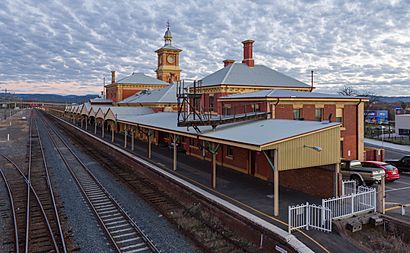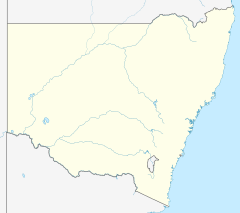Albury railway station facts for kids
Quick facts for kids
Albury
|
||||||||||||||||||
|---|---|---|---|---|---|---|---|---|---|---|---|---|---|---|---|---|---|---|

Station front in July 2015
|
||||||||||||||||||
| Location | Railway Place, East Albury, New South Wales Australia |
|||||||||||||||||
| Coordinates | 36°05′03″S 146°55′28″E / 36.084257°S 146.924559°E | |||||||||||||||||
| Elevation | 163 metres (534 ft) | |||||||||||||||||
| Owned by | Transport Asset Holding Entity | |||||||||||||||||
| Operated by |
|
|||||||||||||||||
| Line(s) |
|
|||||||||||||||||
| Distance |
|
|||||||||||||||||
| Platforms | 2 (1 side, 1 dock) | |||||||||||||||||
| Tracks | 7 | |||||||||||||||||
| Construction | ||||||||||||||||||
| Structure type | Ground | |||||||||||||||||
| Disabled access | Yes | |||||||||||||||||
| Other information | ||||||||||||||||||
| Status | Staffed | |||||||||||||||||
| Station code |
|
|||||||||||||||||
| Website | Transport for NSW Public Transport Victoria |
|||||||||||||||||
| History | ||||||||||||||||||
| Opened | 26 February 1882 | |||||||||||||||||
| Services | ||||||||||||||||||
| Lua error in package.lua at line 80: module 'Module:Adjacent stations/V/Line' not found.
|
||||||||||||||||||
|
||||||||||||||||||
| Official name | Albury Railway Station and Yard | |||||||||||||||||
| Type | Historic | |||||||||||||||||
| Criteria | a., d., f., h. | |||||||||||||||||
| Designated | c. 2012 | |||||||||||||||||
| Reference no. | 105912 | |||||||||||||||||
| Official name | Albury Railway Station and yard group | |||||||||||||||||
| Type | Complex / group | |||||||||||||||||
| Criteria | a., b., c., d., g. | |||||||||||||||||
| Designated | 2 April 1999 | |||||||||||||||||
| Reference no. | 01073 | |||||||||||||||||
| Location | ||||||||||||||||||
Albury railway station is a historic train station in Albury, New South Wales, Australia. It's right next to the border with Victoria. The station was designed by John Whitton and built between 1880 and 1881. It's listed on the New South Wales State Heritage Register because of its important history.
Contents
History
The Albury railway area was the end of the Main Southern Line from 1881 until 1962. It's still a working train yard and passenger station today. It's the last station before trains cross into Victoria.
In the late 1800s, New South Wales (NSW) and Victoria were competing. They both wanted to control the wool trade from the Riverina area. This led to a fast growth of railway lines in both states, heading towards their border. Victoria finished its line to Wodonga by 1873. NSW also wanted to extend its main railway lines. This was to stop wool from the Riverina going to Melbourne by river and Victorian trains.
By 1877, the Great Southern Railway in NSW reached Cootamundra. It quickly extended to places like Wagga Wagga by 1879 and Gerogery by 1880. The section from Wagga Wagga to Albury was built next. The single track from Gerogery to Albury opened on 3 February 1881. The line finally reached the border by crossing the Murray River on 14 June 1883.
The station and yard in Albury opened on 1 March 1881. It had a loop, stockyards, toilets, and a temporary platform. Albury and Wodonga were used as change stations. Passengers and goods were swapped at Albury, and livestock at Wodonga.
A temporary station building and other railway staff homes were built in May 1880. In 1882, a crane and a weighbridge were added. The temporary passenger platform became a loading area.
The new station building officially opened on 26 February 1882. It was designed in a grand Italianate style by John Whitton. This grand building showed NSW's pride as a colony. The leaders of both NSW and Victoria attended the opening. This was the first time two colonial leaders appeared together publicly in Australia.
The New South Wales Government Railways used a different track width (standard gauge) than Victoria. This meant travellers had to change trains at Albury. So, a very long platform, 455-metre-long (1,493 ft), was built. At the time, it was the longest in Australia.
Over the years, more buildings were added. These included refreshment rooms, a goods shed, and a customs office in 1883. An engine shed and a new covered platform were added in 1884. The station also got a furnace for heating foot warmers and a special booking office for sleeping tickets. The platform was extended in 1892 and 1902.
An engine shed, turntable, and coal stage were also built. The original engine shed could hold eight locomotives. The turntable, which turns trains around, was made bigger over time.
Many changes happened in the 20th century. The carriage shed was extended in 1905 and 1912. The platform awning was extended in 1907 and 1944. An Institute building was added in 1921.
Railways became very important during World War II. This was because enemy ships threatened coastal shipping. Also, petrol and rubber were limited. So, more people and goods travelled by train. Passenger numbers at Albury tripled from 1938 to 1941. Goods traffic increased from 25,000 to 123,000 tonnes. The Australian defence forces used the station a lot during the war.
Many changes were made to the station and goods yard before and during World War II. A timber platform for moving goods between trains was added. The station platform was made 66 metres longer. The goods yard was also expanded. After the war, road transport became more common. This meant less activity at the Albury yard.
In 1961, a standard gauge track was built between Wodonga and Melbourne. This meant trains could travel directly without changing tracks at Albury. Some old facilities like the goods shed were later removed.
In April 1962, a new standard gauge line to Melbourne's Spencer Street station opened. This allowed trains like the Southern Aurora to run directly. However, the Riverina Express still ended at Albury until 1993. Passengers then transferred to V/Line services to continue into Victoria.
The refreshment room closed in 1975. Some old railway buildings were demolished or sold. Conservation work was done on the main station building in 1995.
Description
Station Building (1881)
The station building is grand and symmetrical. It's built in the Victorian Italianate style. It has a tall central tower with a fancy cupola on top. The building uses brickwork with painted details. These details include pilasters (flat columns), arches, and quoins (corner stones). The roof is pitched with hipped ends.
On the road side, there's the clock tower and two verandahs. These are supported by double cast iron columns. On the platform side, there are gabled roofs. These are supported by trusses over decorated cast iron columns. The platform is covered along its entire length. It's one of the longest platforms in Australia.
Inside, the building has a central booking hall and ticket office. This area still has much of its original cedar wood details. Other rooms include a ladies waiting room, parcels office, and staff rooms.
A refreshment room was added to the station building in the 1880s. It has its own awning structure. The north end of the building was also extended with a second storey for the refreshment rooms.
Station Master's Residence (1881)
This is a large, two-storey brick house with a slate gabled roof. It has an uneven design with a projecting front bay. There's a two-storey verandah with decorative cast iron railings. The ground floor has a sitting room, dining room, kitchen, and pantry. Upstairs, there are bedrooms, some with fireplaces.
Other station infrastructure
Other important historic structures at the station include:
- Signal Box – an elevated brick and timber box with a gabled roof (1885).
- Signal Box – a brick box at the southern end of the platform (1962).
- Barracks – brick buildings for engine drivers at 508 Young Street (around 1890).
- Footbridge – at the northern end of the platform.
- Turntable – used to turn locomotives around.
- Transhipment Shed – a covered shed with a central platform (around 1920).
- Gantry cranes – large cranes for lifting heavy items.
- Broad gauge cripple sidings – tracks for damaged trains (now an interpretive display).
Condition
As of July 2013, the station buildings are in very good condition. Other structures are generally in good shape. Some repairs are needed for the signal box and transhipment shed. The station buildings, signal boxes, and Station Master's residence are largely original and well-preserved.
Platforms & services
Albury station is served by NSW TrainLink XPT trains. These run from Sydney Central to Melbourne Southern Cross. It also has V/Line services that start and end here, connecting to and from Melbourne Southern Cross.
| Platform | Line | Stopping pattern | Notes |
| 1 |
Southern Region
|
Services to Melbourne and Sydney | |
|---|---|---|---|
| 2 | V/Line North East Line | Services to & from Melbourne |
Transport links
- Greyhound Australia runs bus services between Canberra and Melbourne, stopping at Albury station.
- NSW TrainLink operates bus services from Albury station to Echuca.
- V/Line operates bus services from Albury station to Kerang, Adelaide, Canberra, Seymour, and Wangaratta.
Heritage listings
Albury railway station is very important to Australia's history. It's listed on the Australian National Heritage List and the New South Wales State Heritage Register.
It played a big role in Australia becoming a united country (Federation). It also helped defend the nation during World War II. The station shows how the different colonies came together to form Australia. The connection of the NSW and Victorian railway systems at Albury-Wodonga was a huge step towards Federation. It was a major engineering success. The grand station building showed NSW's pride in reaching the border.
The station yard was designed to handle trains with different track widths. This "break-of-gauge" showed the competition between the two colonies. Even after Federation, the different track widths continued. This shows how hard it was for the colonies to agree. Changes to the yard over time show how relations between states changed. They also show how goods transport improved, especially during wartime. Eventually, a single national freight network developed.
The break-of-gauge was also important during World War II. When Japanese submarines threatened coastal shipping, rail transport became vital. Moving military supplies, goods, and soldiers at Albury station was a big part of the war effort at home. Famous artist Russell Drysdale even painted pictures of Albury Railway Station during the war. These pictures helped shape how Australians saw the war at home.
Albury Railway Station became a key point on a national route. It was unique in regional Australia. The long platform was known to many generations of train travellers. It's seen as an important part of Australia's cultural history.
The station building, signal box, and station master's residence are listed on the New South Wales State Heritage Register. This is because Albury is one of the most important railway areas in NSW. The station's grandeur shows how important this location was to the NSW government in the late 1800s. It also shows the rivalry between NSW and Victoria. The buildings remind us of the important role railways have played in Albury since the 1880s.
The station is significant because it was the point where train tracks changed width between NSW and Victoria. Passengers and goods had to transfer here from 1881. The railway area was also important during World War II. Moving freight and military staff here helped the war effort.
The barracks building at Albury is a great example of railway worker housing from the late 1800s. It shows how railway crews were housed at important locations across the state.
Gallery






